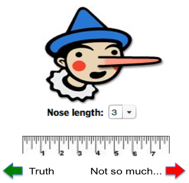By guest blogger Craig Baxter.
Craig-James Baxter is the founder & owner of Understanding Body Language. Liars, Cheats and Happy Feet, and has achieved the highest grade possible (A+) in his non verbal communication final and furthermore, is now a master trainer in reading advanced micro expressions with Elite Humintell training. Find out more about him at this website, or at the links at the end of this post.
 With so many pitfalls, how do you detect deceit?
With so many pitfalls, how do you detect deceit?
Research has indicated that a higher pitch of voice, a slower speech rate, fake smiles (microexpressions), persuasive head movements, immediacy (none immediate answers) and a lack of plausibility are reliable signs of deceit, so long as they appear in a cluster, not singularly.
But be aware, there is no clue akin to Pinocchio’s nose in detecting deceit. However, for more accuracy, the lie spotter should focus their attention on the words of the liars, as these are the carriers of deceit. In my opinion, analysing the statements of the liar is more effective than looking for non-verbal signs of deceit, due to the analyser either having an incorrect belief about what behaviour the ‘typical’ liar shows, or being unable to interoperate the non-verbal behaviour that is on show, thus rendering an innocent person guilty.
The global view about liars is that they look away from you (avert their gaze) when they are lying. This is a false belief, which can be backed up with 40 years of research. What you will often find is that liar’s will often consciously engage in greater eye contact, because it is commonly (but mistakenly) believed that direct eye contact is a sign of truthfulness. Some eye gaze behaviour is well rehearsed, such as when women use their gaze to attract males and persuade them into taking a course of action they might not otherwise have taken.
Another reason is that eye gaze is related to many factors that have nothing to do with deception. People make less eye contact when they are embarrassed and make more eye contact when dealing with people of high status than low status. Additionally, people avoid eye contact with others who sit too close to us, and, as mentioned, women use eye gaze to emotionally manipulate. (Vrij, 2008) For these reasons, no relationship exists between eye gaze and deception.
One issue arises when you think about the physiological aspect of telling a high stakes lie, one in which the punishment for deceit is severe to the individual. Studies have shown that heavy cognitive load (deep thinking) lowers behavioural animation. (Vrij, 2008) So for example, someone’s blinking rate might decrease when they are trying to think of a convincing (yet deceptive) answer to your question.
However, their blinking rate might dramatically increase straight after their answer because: A. The liar doesn’t know what the target knows, and they might have solid (truthful) evidence that contradicts their story. B. The liar becomes increasingly anxious that the target is actually adept in lie catching.
The fear of getting caught out will increase autonomic stress in the body (increases in breathing rate, blood pressure, heart rate) which will manifest themselves as an increase of movements due to an increase blood demand to the brain & working muscles. So you have a problem. Cognitive load decreases movements, but one of the emotional responses to fear is to increase movement (apart from the flash freeze limbic response).
So here is a technique you can use if you suspect someone is not being honest with you.
The objective here is to ask a question that does not accuse the person of anything, but alludes to that person’s possible behavior. The key is to phrase a question that sounds perfectly innocent to an innocent person, but like an accusation to the guilty.
I hope the following sheds some light on the difficult yet fascinating world of detecting dishonesty and evaluating credibility.
You can learn more about Craig by visiting his Facebook page, watching his video analysis on his YouTube Page and byfollowing him on twitter
 Detecting deception is a truly difficult task, and I do hope the following will help you become more adept in spotting dishonesty.
Detecting deception is a truly difficult task, and I do hope the following will help you become more adept in spotting dishonesty. Many of us judge a person’s emotional state by their Facial Expressions. Whether we do this consciously or not facial expressions of emotion are a big part of nonverbal communication.
Many of us judge a person’s emotional state by their Facial Expressions. Whether we do this consciously or not facial expressions of emotion are a big part of nonverbal communication.